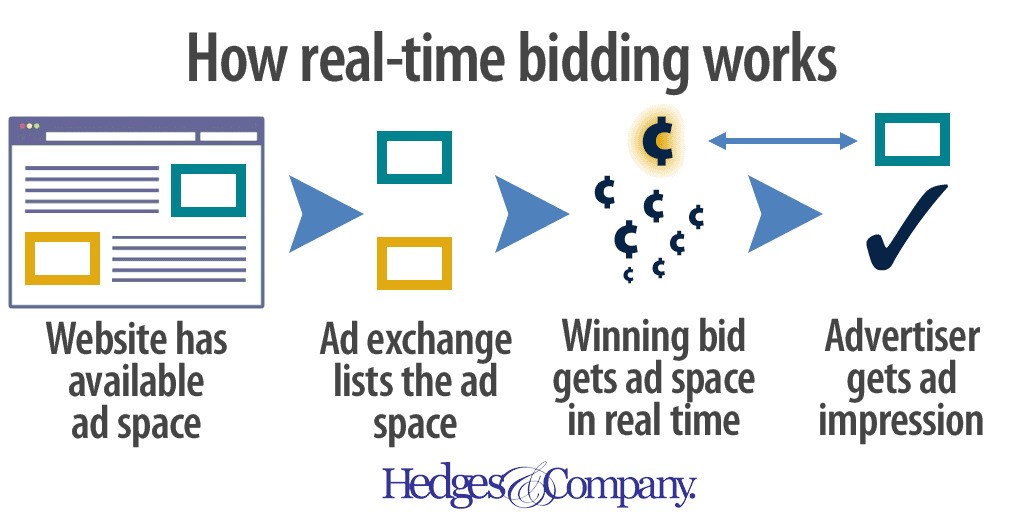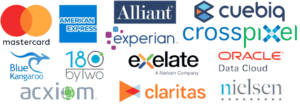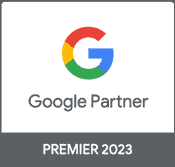What is Programmatic Marketing?
How programmatic marketing works in automotive:
What is programmatic marketing? In the last decade, programmatic marketing shook up the marketing world in many industries. It’s now available to the automotive aftermarket.
It’s a fundamental change in advertising technology, like the way radio or TV ads were, a couple of generations ago.
Programmatic marketing is rapidly growing with some estimates that put spending at $96 million in 2022 in the US, across all industries. This includes display ads and video ads.

CLICK TO ENLARGE: Programmatic marketing uses real-time bidding to instantly place ads on websites. This process is usually managed by a programmatic marketing company.
Regardless of what automotive product or service you’re selling, you must reach the right people at the right time.
Programmatic marketing is an innovation connecting automotive companies to individual automotive parts buyers on websites or phone apps, using digital online audiences.
Programmatic marketing uses real-time bidding (RTB)
We illustrate real-time bidding here. It starts with a website (let’s say CNN or The Weather Channel) with available ad space, or inventory. This is done with a publisher’s supply-side platform (SSP). The ad inventory gets listed as “available” with ad exchanges. These ad exchanges list this inventory using demand-side platforms (DSPs).
In an instant, bids are solicited for the ad space from DSPs. The winning bid is accepted by the SSP. The advertiser gets to display an ad and the advertiser gets an ad impression. This process takes about 200 milliseconds.

CLICK TO ENLARGE: Just some of the hundreds of big data companies providing audiences to programmatic marketing advertisers. These audiences are selected by a programmatic agency to match marketing goals.
That’s a very simplified description, as you might imagine.
These ads must be shown to the right automotive parts shoppers, otherwise programmatic marketing would be wasting marketing dollars. That’s where audiences become part of the equation.
Real time bidding shows ads to audiences
As we mentioned the process to list ad inventory, analyze a website visitor, accept a bid and display an ad is nearly instant. That’s why this process is called “real time bidding.”
Targeting specific website visitors is where audiences come in.
Big data companies create audiences used for programmatic marketing. These audiences are created from consumer behavior, browsing history, interests or off-line shopping behavior. These are called third-party audiences. Tens of thousands of audiences are available. Audiences are combined, creating even more audiences.
An audience can also be a remarketing audience. This is also called a first-party audience. People who have visited a specific website, or specific pages within a website go into a remarketing audience.
Audiences can be extremely complex. That’s why a programmatic advertising company usually manages this process.
Here are just a few examples of automotive parts audiences:
Shoppers in-market (ready to buy) for auto parts and accessories, by vehicle make or model
Automotive parts spenders who spend the most money, as verified by American Express
Enthusiasts watching auto TV shows like Chasing Classic Cars or Overhaulin’
Automotive enthusiasts with an interest in vintage, performance or classic cars
Performance automobile enthusiasts
Consumers who shopped at AutoZone, Advance Auto Parts, O’Reilly or other parts stores
Automotive enthusiasts who own an off-road vehicle
What’s the benefit of this technology?
Programmatic marketing turns ad buying and placement over to software and algorithms. It removes limitations of having to buy banner ads on one particular website. It opens up the opportunity to show ads to highly targeted automotive parts buyers, whatever website they’re on.
Programmatic shows ads to people based on who they are, what they want and when they want it, not where they are on the internet.
A programmatic agency manages this process for a marketer. The agency selects audiences and concentrates on the actual optimization and fine-tuning of the ads. This takes away the headaches of buying and managing digital media. More importantly it opens up a marketing technology formerly used by huge corporations. It is available to nearly any automotive aftermarket company. It utilizes large budgets or small budgets.
With programmatic marketing, you don’t tie up time in bid tenders, negotiations, analysis or the other nuts and bolts of digital marketing. There’s no more “hit-and-miss” typical with older marketing technologies.
Real-time bidding is remarkably cost-effective and efficient. It constantly measures ad spend vs. total budget for performance. Fine-tuning happens continually.
It’s important to remember a campaign needs to run two to eight weeks. This is because algorithms “learn” over time to only serve ads to people likely to convert to a buyer. This is true for all demand side platforms using real-time bidding. When a campaign is live it goes through mutliple optimizations as the algorithms “learn” to find receptive prospects to serve ads to. These algorithms learn using artificial intelligence by factoring in “events” like clicks or conversions.
Marketers everywhere take advantage of the benefits of programmatic marketing. It’s a perfect fit for automotive aftermarket companies looking for a scalable solution for their digital marketing technology.
Programmatic marketing is a growth industry
Programmatic marketing took off like a rocket in the ten or so years since it first hit the scene. About 70 percent of all digital media ad buys use programmatic marketing. In 2019, total programmatic marketing buys across all industries came to about $100 billion around the world. That number is growing to $127 billion in 2020 and a estimated $147 billion world-wide in 2021.
Advertisers in the US have the lion’s share of world-wide programmatic marketing, with about 60% of all the programmatic ad buys in the world. China is a distant second with about $16 billion in spending. The UK is third with about $7 billion.
Programmatic marketing Q&A
Programmatic marketing, real-time bidding, ad exchanges and audiences are complex. Let’s have a quick Q and A:
Q: What is programmatic marketing?
A: Programmatic marketing is an advanced marketing technology using automated real-time bidding to purchase ad inventory (display ads and video ads) on websites. It reaches specific users in pre-defined audiences.
Q: Is programmatic marketing the same as marketing automation?
A: The two terms are similar, but they aren’t quite interchangeable. Programmatic marketing pertains strictly to paid media buying and not an entire multi-channel campaign. It is strictly for display ads, including video.
Q: Is Google Ads considered to be programmatic marketing?
A: Google ads are different from programmatic ads. Google Ads run on Google. Programmatic doesn’t include pay-per-click, paid search or Shopping ads through Google. Here’s a quote from programmatic company Zenith Media. “Digital media refers to all forms of paid-for advertising…including banners, online video and social media…excluding paid search and classified ads.”
Q: Is programmatic ad buying limited to ad exchanges?
A: Yes. Ad exchanges bring together publishers, advertisers, agencies and networks in a platform. They buy and sell ad impressions in a totally automated process. Let’s say a web user loads a page on an automotive website. That triggers the publisher ad server to announce available ad inventory. Advertisers then place an ad on that page using an ad exchange. The exchange shows an ad custom-targeted to the page and the user.
Q: What’s an ad exchange?
An ad exchange is a technology platform managing the buying and selling of ad inventory. Some of the larger ad exchanges include these companies:
Rubicon Project
PubMatic
Index Exchange
OpenX
DoubleClick (Google’s ad exchange)
AppNexus
Taboola
VerticalScope
Q: What is real-time bidding (RTB)?
A: Real-time bidding shows an ad to a targeted customer (a member of an audience) in a targeted context (a specific kind of webpage). It happens thanks to a line of JavaScript embedded in a website’s header. When a user loads a web page, the code reaches out to ad exchanges for bids. This happens before its own ad server is notified. Bidding happens automatically and simultaneously. A winning bid is determined, and the ad request is then passed along to the publisher’s ad server. The ad server then confirms the bid and the ad is displayed, all within 200 milliseconds.
Q: Why is programmatic marketing important?
A: It is important because it uses precision targeting to reach custom audiences designed for your business. The automotive aftermarket is a niche industry and this is an excellent way to connect with parts buyers in a direct, targeted way. That’s probably one of the single biggest benefits of this technology. It gives marketers the ability to zero in on a demographic at a granular level that would have been impossible ten years ago.
Q: Is programmatic marketing effective?
A: Here’s a useful example from the respected British magazine The Economist. Without getting too far into the weeds here, The Economist looked at the web/app usage of their subscribers. They analyzed their subscribers’ interests. From there, they broke down cookie, subscriber and other data sets into the magazine’s seven editorial segments. They built “lookalike audiences” and the magazine created in-context links to give readers a push toward other relevant stories. Out of a target of 650,000 new prospects, they reached 50% of that target in just nine days. The campaign saw an ROI of over 10 to 1.
Changes in the marketing landscape
We all know that online digital marketing is constantly evolving, and one thing that’s changing is a pivot away from using third-party cookies for targeting insights. More and more providers and consumers are rightly concerned about privacy. Some browsers block third-party cookies completely. With things headed in that direction, it’s important to rethink how marketing is done and how it can be most effectively targeted.
The demise of cookies means an opportunity for high-quality first-party data in real time that still respects users’ privacy rights, and that’s where programmatic marketing can be an excellent fit. Programmatic is basically cookie-less. Real-time bidding is an excellent fit for both short-term performance campaigns and long-running branding efforts. It zeroes in on a target user in a really effective and cost-efficient way.






